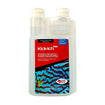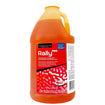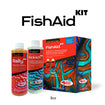- No products in the cart.
Keeping Your Fish Healthy With Aquarium Disease Treatment
05
Jul

Aquarium enthusiasts often face the challenge of disease management within their aquatic habitats. A disease outbreak can quickly escalate, endangering the health of all the tank inhabitants and potentially leading to significant losses. Understanding how to effectively treat and prevent diseases is crucial for maintaining a healthy aquarium. This blog delves into the common diseases in aquarium fish, how to diagnose them, and the most effective treatments available.
Understanding Aquarium Diseases
Aquarium diseases treatment can be broadly categorized into bacterial, viral, fungal, and parasitic infections. Each type of disease requires a specific approach to treatment, making accurate diagnosis crucial. Common signs of disease include unusual swimming patterns, discoloration, visible spots or lesions on the body, lethargy, and loss of appetite. Early detection plays a vital role in successful treatment.
Common Aquarium Diseases and Their Treatments
1. Ichthyophthirius Multifiliis (Ich):
Symptoms: White spots resembling grains of salt on the body and gills.
Treatment: Raise the water temperature gradually to speed up the parasite's lifecycle and use copper-based medications or malachite green. It's crucial to treat the entire tank since Ich is highly contagious.
2. Fin Rot:
Symptoms: Frayed or disintegrating fins, often starting at the edges.
Treatment: Improve water quality and use antibacterial treatments such as erythromycin or tetracycline. Maintaining good water conditions is essential to prevent recurrence.
3. Velvet Disease (Oodinium):
Symptoms: Fine, dusty, gold-to-rust-colored film over the body and eyes.
Treatment: Dim the lights (as the parasite photosynthesizes) and treat the water with copper-based medications or formalin.
4. Dropsy:
Symptoms: Swollen body, raised scales, and bloating.
Treatment: Often difficult to treat effectively, but efforts can include antibiotic injections and medicated baths. Improving water quality is critical.
5. White Spot Disease:
Symptoms: Similar to Ich but caused by different parasites.
Treatment: Increase aquarium salt concentration and use anti-parasitic treatments.
Diagnosing Fish Diseases
Accurate diagnosis is the first step in effectively treating aquarium diseases. Observing the symptoms is vital, but sometimes further analysis is necessary:
Quarantine: Isolate the affected fish to prevent the spread of the disease and monitor symptoms in a controlled environment.
Water Testing: Regularly test water parameters (ammonia, nitrite, nitrate, pH, temperature) to ensure they are within safe limits, as poor water quality often contributes to disease.
Consultation: Seek advice from veterinarians or experienced aquarists, especially for complex cases or when dealing with unfamiliar diseases.
Preventive Measures
Prevention is always preferable to treatment when it comes to aquarium diseases. Here are some preventive measures every aquarist should consider:
Quarantine New Arrivals: Always quarantine new fish for at least two to four weeks before introducing them to your main tank.
Regular Water Changes: Maintain a strict schedule of regular water changes to keep the water clean and stable.
Proper Feeding: Overfeeding can lead to poor water quality. Feed small amounts and remove any uneaten food.
Stress Reduction: Minimize stress for your fish by maintaining proper tank conditions and avoiding overcrowded conditions.
Conclusion
Effective treatment and prevention of aquarium diseases require a proactive approach and a good understanding of the causes and treatments. Regular monitoring, proper quarantine practices, and maintaining excellent water quality are essential steps every aquarist should take to ensure their fish remain healthy and vibrant. By being vigilant and prepared, you can ensure that disease outbreaks are quickly managed and potentially avoided altogether, leading to a thriving aquarium environment.





